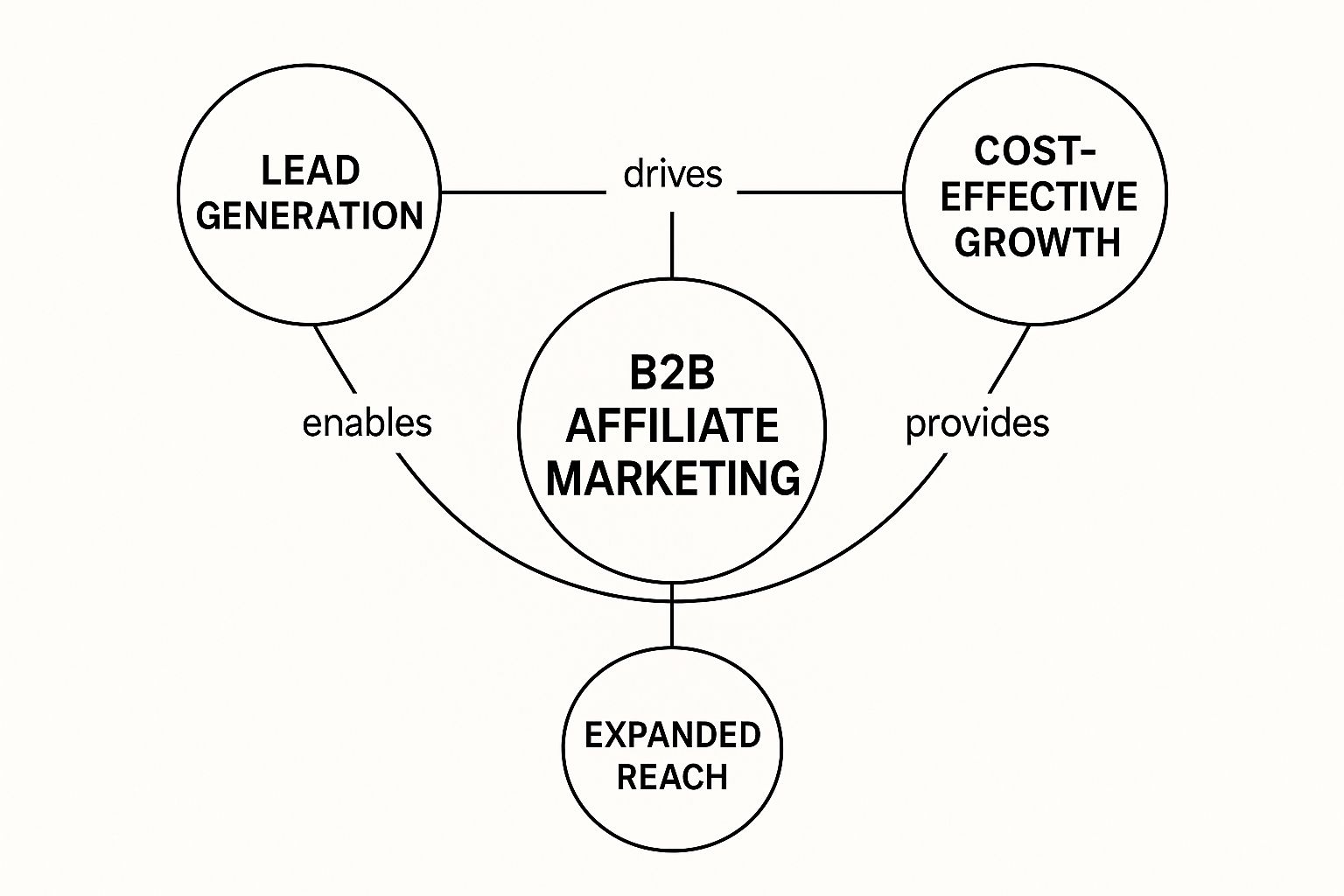Affiliate marketing in the B2B world is really all about strategic partnerships. You team up with trusted industry experts—think consultants, influential bloggers, or even tech companies with a complementary product—and reward them with a commission when they send new customers your way.
This isn't about blasting coupon codes to the masses. It’s a performance-based model built on a foundation of authority and credibility, which is perfect for products that naturally have a longer sales cycle. In essence, you're building a highly specialized, external sales team that you only pay for tangible results.
Why B2B Affiliate Marketing Is a Strategic Advantage
Imagine traditional marketing as shouting your message through a megaphone at a crowded conference, hoping the right people happen to be listening. B2B affiliate marketing, on the other hand, is like a respected industry advisor pulling a potential customer aside and personally recommending your solution.
It's a powerful switch from broad-stroke advertising to highly targeted, trust-based referrals. This approach is a game-changer for SaaS and tech companies because it mirrors how businesses actually buy things: through careful research, expert reviews, and recommendations from people they already trust.
At its heart, this strategy is about borrowing someone else's hard-won credibility. Instead of you telling the market how great your product is, an established thought leader or a complementary software company is demonstrating to their audience how your tool solves a real-world problem they're facing. That third-party validation is incredibly powerful and can dramatically shorten the notoriously long B2B sales journey.
A Modern Growth Engine
So, what makes this model so effective right now? It's a remarkably cost-efficient and scalable way to bring in high-quality customers. You get to sidestep the ever-rising costs of paid ads and only pay when you see a genuine conversion. This gives you a predictable Customer Acquisition Cost (CAC) and a crystal-clear return on investment.
Even better, it opens doors to niche markets you might struggle to reach on your own. Your affiliate partners have spent years, sometimes decades, building a loyal audience that hangs on their every word. When they endorse your product, you get an instant injection of credibility and access to that entire community.
This is more than just a sales channel; it’s a full-fledged system for driving growth, as this graphic shows.

As you can see, it’s not just about one-off sales. It’s a holistic system for generating qualified leads, scaling your business cost-effectively, and extending your market footprint through trusted alliances.
The Shift from B2C to B2B
While the concept of affiliate marketing definitely has its roots in the B2C space (think Amazon Associates), its momentum in the B2B sector is undeniable and picking up speed. The numbers back this up: as of 2025, over 81% of brands have adopted affiliate programs, a clear sign that businesses are seeing the immense value in performance-based partnerships.
In fact, B2B SaaS and software programs are now offering some of the most generous commissions out there—often ranging from 20% to 70% per sale. This makes the model incredibly attractive for both the companies running the programs and the partners promoting them. If you're curious, you can explore more about these industry trends and statistics to get a fuller picture of just how much this field is growing.
Key Differences Between B2B and B2C Affiliate Marketing
To truly grasp why B2B affiliate marketing requires a different playbook, it helps to see it side-by-side with its B2C counterpart. The goals, the partners, and the customer journeys are fundamentally different.
| Attribute | B2B Affiliate Marketing | B2C Affiliate Marketing |
|---|---|---|
| Typical Partner | Industry experts, consultants, thought leaders, complementary tech companies, and trade publications. | Mass-market influencers, coupon/deal sites, bloggers, and content creators with large audiences. |
| Sales Cycle | Long and complex, often involving multiple decision-makers and months of consideration. | Short and transactional, frequently driven by impulse buys and immediate need. |
| Commission Structure | High, often recurring commissions per sale, reflecting higher customer lifetime value. | Low, one-time commissions per sale, focused on driving high volume. |
| Customer Motivation | Driven by ROI, efficiency, solving complex business problems, and long-term value. | Driven by price, desire, brand appeal, social proof, and personal needs. |
| Marketing Focus | Building trust and authority through in-depth content, case studies, and expert validation. | Creating broad awareness and urgency through promotions, reviews, and social media buzz. |
As the table shows, B2B is a long game focused on building relationships and demonstrating value, while B2C often prioritizes volume and quick conversions. Understanding this distinction is the first step to building a B2B affiliate program that actually works.
Why a B2B Affiliate Program Is a Growth Multiplier

Thinking of affiliate marketing for B2B as just another sales channel is like seeing a rocket ship and calling it an airplane. Sure, both get you from point A to B, but one is built for a totally different scale of ambition. A well-run affiliate program isn't just about adding a bit of incremental revenue; it's a powerful growth multiplier that can supercharge your entire go-to-market strategy.
It's not about creating simple transactional relationships. It’s about building a strategic ecosystem around your brand. Your partners effectively become an extension of your marketing team, but with one massive advantage: they already have the trust and attention of the exact audience you’re trying to reach.
This "borrowed trust" is the program's secret sauce. Instead of spending months or even years building credibility from the ground up, you tap into an existing relationship, instantly positioning your product as a vetted, recommended solution.
Accelerate Market Penetration and Brand Authority
Breaking into a new market or industry vertical is a slow, expensive grind. You have to build awareness, establish credibility, and fight for traction against incumbents. A smart affiliate program acts as a shortcut, giving you a way to penetrate these new markets with surprising speed.
Think about it. Your affiliates—whether they’re industry consultants, niche bloggers, or other tech companies—have already done the heavy lifting of building a loyal following. When they introduce your product, it’s not a cold pitch. It’s a warm recommendation from a source their audience already knows and trusts.
This dynamic unlocks a few key advantages:
- Instant Audience Access: You get immediate exposure to highly targeted, relevant audiences that would otherwise take ages and a significant ad budget to reach.
- Enhanced Brand Credibility: A nod from a respected expert carries far more weight than any ad you could run. This third-party validation builds your brand's authority and signals to the market that you're a serious player.
- Resilient Lead Generation: Paid ad campaigns die the moment you turn off the budget. An affiliate program, on the other hand, creates an evergreen engine for leads. Your partners' content—reviews, tutorials, and case studies—keeps attracting and converting qualified prospects long after it’s published.
The global affiliate marketing industry has ballooned to over $17–$18.5 billion, and it's still growing every year. This boom is fueled by the shift in B2B sales, where trust and expert validation have become absolutely essential.
Shorten Long B2B Sales Cycles
We all know the B2B buyer's journey is long and winding. It often involves multiple stakeholders, tons of research, and a lengthy consideration phase. Affiliates are brilliant at compressing this timeline by providing the social proof buyers need at crucial decision points.
A potential customer might read a blog post from one affiliate comparing your software to a competitor. Later, they could watch a video tutorial from another partner showing off a key feature. Each of these touchpoints reinforces your value and builds the confidence they need to make a purchase. This distributed network of validation helps buyers get past their objections and moves them through the funnel much faster.
The industry is catching on to this. For instance, 58% of brands say affiliate marketing is effective for increasing brand awareness—a critical first step in nurturing those long-term B2B relationships. You can dive deeper into these trends and see how affiliate marketing is shaping brand discovery by checking out these industry statistics on Hostinger.
Achieve Predictable Costs and Higher ROI
Finally, let's talk about the money. The financial model of affiliate marketing is incredibly efficient. It’s a pure performance-based channel, which means you only pay for actual results—a qualified lead or a closed sale. This setup all but eliminates the upfront risk and wasted spend that plagues traditional advertising.
This structure gives you a predictable customer acquisition cost (CAC), making your financial forecasting more accurate and scalable. When you stack it up against the fluctuating costs of pay-per-click (PPC) campaigns or the high overhead of a direct sales team, the return on investment (ROI) from a well-managed affiliate program is often in another league. You're not just buying clicks; you're investing in high-intent customers delivered by advocates your market already trusts.
How to Find and Recruit High-Value B2B Partners

A successful B2B affiliate program lives and dies by the quality of its partners. This is where it really diverges from the B2C world. Forget chasing high-volume coupon sites; in B2B, you need partners who have real authority and have earned the trust of your target customers.
Think about it. Your ideal partners are already the go-to advisors for the businesses you want to reach. They’ve spent years building that credibility, so their recommendation actually means something. This is why recruiting them isn't about just flashing a commission rate. It’s about building a genuine strategic alliance where everyone wins.
Defining Your Ideal Partner Archetypes
Before you even think about outreach, you have to know exactly who you're looking for. High-value B2B affiliates aren't a monolith; they usually fall into a few key categories. Focusing your search here will save you a ton of time and get you much better results.
- Industry Consultants and Coaches: These are the people on the front lines, working directly with your ideal customers and solving the very problems your product is built for. They have incredible trust and know their clients' pain points inside and out.
- Respected Thought Leaders and Niche Content Creators: I’m talking about the bloggers, podcasters, and YouTubers who create deep, expert-level content for a specific professional crowd. Their influence comes from their specialized knowledge, not just a big follower count.
- Complementary Tech Companies: Finding another business that serves your same customer base with a non-competing tool is a goldmine. A joint marketing effort feels completely natural and adds a ton of value for both of your audiences.
- Professional Associations and Training Organizations: These groups are the central watering holes for professionals in your industry. A partnership here gives you a direct line to a community that is already highly engaged and perfectly aligned with your product.
The core mindset shift you need to make is from asking, "Who has the biggest audience?" to "Who has the most trusted voice with my ideal customer?" That single distinction is the bedrock of a solid B2B affiliate recruitment strategy.
Strategies for Discovering the Right Partners
Once you have your partner profiles dialed in, it’s time to actually find these people. This isn't about a simple Google search for influencers. It's more of an investigative process. Your goal is to uncover the people and organizations that the decision-makers in your industry actually pay attention to.
Start by mapping out your customer's ecosystem. Where do they go to learn? Who do they follow on LinkedIn for industry news? What podcasts or newsletters can they not miss? The answers to these questions will reveal a treasure trove of potential partners.
If you want a more step-by-step plan, our guide on how to find affiliates lays out a detailed playbook for uncovering some of these hidden gems.
Effective Outreach That Builds Alliances
Your first message can make or break a potential partnership. Generic, copy-paste emails get deleted instantly. B2B professionals are fiercely protective of their reputation and their audience, so your pitch has to connect with their own business goals. Your outreach needs to be personal, professional, and laser-focused on mutual benefit.
Here’s a simple framework for crafting an outreach message that actually gets a response:
- Lead with genuine admiration: Open by mentioning a specific article, podcast episode, or talk of theirs that you genuinely enjoyed. It immediately shows you’ve done your homework.
- Highlight audience alignment: Quickly and clearly explain why your product is a perfect match for the audience they serve. Connect the dots for them so they don't have to.
- Frame it as a partnership: Ditch the phrase "affiliate program" and instead use language like "strategic alliance" or "collaborative opportunity." It’s all about showing how you can help them deliver more value.
- Outline the benefits (for them): Go beyond the commission. Mention things like co-marketing opportunities, exclusive content for their audience, or access to a dedicated partner manager.
- Keep it short and actionable: Respect their time. Keep the email brief and end with a clear, low-friction call to action, like, "Would you be open to a quick 15-minute chat next week to explore this?"
This approach turns a cold email into a warm invitation for a real conversation. It proves you see them as a partner in growth, not just another link in your affiliate chain.
Designing Your B2B Affiliate Program Structure

Think of building a B2B affiliate program like constructing a custom home. You wouldn't start hammering nails without a solid blueprint, and the same principle applies here. Your program's structure is the foundation that determines whether it will attract top-tier partners and stand the test of time.
If you throw together a program with confusing payouts or unrealistic rules, you'll struggle to recruit anyone worthwhile. But a well-designed program creates a win-win scenario, aligning incentives and setting clear expectations for scalable, long-term growth. This is where you define the rules of the game.
Choosing the Right B2B Commission Model
The heart of your program is its commission structure. This is what motivates affiliates to send high-quality traffic your way. It needs to be attractive enough to catch their attention but also sustainable for your business, keeping your Customer Lifetime Value (LTV) front and center.
There's no single "best" model; it all depends on what you're selling. For B2B, you'll generally see a few proven approaches.
We’ve put together a table to quickly compare the most common models and help you see which one might be the right fit for your business.
Comparing Popular B2B Affiliate Commission Models
| Commission Model | How It Works | Best For | Key Consideration |
|---|---|---|---|
| Recurring Revenue Share | Affiliates earn a percentage of the customer's subscription payment for a set period—often for life. | SaaS and subscription-based products with strong customer retention. | Motivates partners to find loyal, long-term customers, not just quick sign-ups. |
| High One-Time Payout (CPA) | A large, single payment is made for each new paying customer an affiliate brings in. | High-ticket software, one-off enterprise sales, or annual-only plans. | Simple to track and offers an immediate, substantial reward for conversions. |
| Tiered Commissions | Commission rates increase as an affiliate hits pre-defined sales or revenue targets. | Programs looking to reward and motivate top performers. | Creates a powerful incentive for your best partners to keep pushing for more sales. |
Each of these models has its place. The key is to choose the one that aligns with your product’s pricing and sales cycle while offering a compelling reason for partners to promote you over a competitor. For a more detailed breakdown, our guide on https://refgrow.com/blog/commission-structure-examples offers a deeper look at these options.
Setting a Fair and Effective Cookie Duration
In the B2C world, a 24-hour cookie might work for an impulse purchase. But in B2B, that’s a non-starter. The B2B buying journey is long and complex, often involving weeks of research, multiple decision-makers, and several demos. Your cookie duration—the window where an affiliate gets credit for a sale after their link is clicked—has to reflect this reality.
A 90- to 180-day cookie duration is a good starting point for most B2B SaaS programs. This longer window shows partners you understand their role isn't just to get the last click but to nurture leads over time. Offering a short cookie duration is one of the quickest ways to signal that you don't value your partners' effort.
A generous cookie duration signals a true partnership. It tells affiliates you value their influence throughout the entire buyer's journey, not just the final click. This builds trust and encourages them to invest in creating high-quality, evergreen content that nurtures leads over the long haul.
Selecting the Right Tools and Platforms
Trying to manage an affiliate program with a spreadsheet is a recipe for chaos. As you scale, you need a robust platform to handle link tracking, performance reporting, and commission payouts accurately. This software is the central nervous system of your entire program.
Specialized tools are essential for running a professional operation. Platforms like Tolt affiliate management software, PartnerStack, or Impact provide the infrastructure to create a transparent and efficient system for both you and your partners.
This is a fast-growing space. In the U.S. alone, there are now around 11,400 affiliate programs, and that number is climbing every year. Choosing the right platform from the start ensures you have the technology to manage that growth without the headaches.
Empowering Your Affiliates for Long-Term Success
https://www.youtube.com/embed/5BaxErQKq_g
Getting high-quality partners to sign up is a huge win, but it’s really just the beginning. The best B2B affiliate programs I’ve seen all treat launch day as the starting line, not the finish line. True, lasting success comes from actively cultivating these relationships and turning your affiliates into genuine brand champions.
Think of your affiliates as an extension of your own team—a specialized, remote sales and marketing force. Just like your in-house staff, they need the right tools, clear communication, and a reason to stay motivated. Just sending them a link and hoping for the best is a surefire way to end up with a dormant, ineffective program.
The real objective here is to build a system that supports, educates, and empowers your partners. When they win, you win. This means you have to deliberately and consistently invest in their growth, making sure they have everything they need to represent your brand with confidence and skill.
Build a Comprehensive Affiliate Resource Center
First things first: create a central hub where your affiliates can find everything they need, no questions asked. A good resource center gets rid of the guesswork and friction, letting partners get up and running fast. It should be their go-to spot for marketing assets, brand info, and product knowledge.
A well-stocked resource center immediately signals that you run a professional program and are serious about their success. It builds trust from day one.
Here’s what you absolutely need to include:
- Brand Guidelines: Lay out the ground rules on how to use your logo, what your brand voice sounds like, and key messaging to keep everything consistent.
- Marketing Assets: Load it up with a library of pre-approved banners, social media graphics, and even swipe copy for emails. Make it easy for them.
- Product Deep Dives: Give them access to demo videos, detailed feature comparisons, and compelling case studies they can use in their own content.
- Target Audience Personas: Don't make them guess. Show them exactly who they should be talking to and what problems your product solves for them.
An affiliate resource hub isn’t just a glorified Dropbox folder; it’s an enablement tool. When you arm your partners with high-quality, ready-to-use materials, you dramatically lower the barrier to entry and make it far more likely they’ll actually create great content that converts.
Maintain Consistent and Valuable Communication
Out of sight, out of mind. Radio silence is a momentum killer. Regular communication keeps your program on your affiliates' radar and makes the partnership feel real. A simple monthly newsletter can do wonders for keeping people engaged and motivated. This isn't just about blasting out updates; it's about building a community.
Remember, communication should be a two-way street. You want to provide value, but also open the door for them to give you feedback.
Your newsletter is the perfect place for:
- Performance Insights: Share some high-level data on what’s working across the program (e.g., "Webinars converted 15% better last month!").
- Success Stories: Feature a top-performing affiliate. This not only gives them recognition but also inspires others by showing them what’s possible.
- Product Updates: Let them know about new features they can get excited about and promote.
- Exclusive Content: Give them a heads-up on new promotional materials or upcoming campaigns they can prep for.
Motivate Top Performers with Advanced Incentives
Your base commission is crucial, but if you really want to light a fire under your top performers, you need to think bigger. Recognizing and rewarding your best partners encourages them to double down on what’s working and builds serious long-term loyalty.
These incentives should feel special—something beyond the standard payout that creates a sense of an exclusive partnership. A great way to do this is with a tiered system where partners unlock better rewards as they hit specific sales or revenue goals.
Here are a few powerful motivators that work like a charm:
- Tiered Commissions: This is a classic for a reason. Bump up the commission rate after they hit a certain number of sales (e.g., 20% for the first 10 sales, 25% for every sale after that).
- Performance Bonuses: Offer a one-time cash bonus for hitting a big quarterly goal or for driving a specific number of high-quality trial sign-ups.
- Co-Marketing Opportunities: This is a big one. Invite your top partners to co-host a webinar with your team, contribute a guest post to your blog, or even feature them in an official case study.
This kind of structure creates a clear path for growth within your program. It shows affiliates their hard work is genuinely valued and gives them something concrete to strive for, which in turn deepens their commitment to you and your brand.
Measuring Performance and Avoiding Common Mistakes
Running a B2B affiliate program without solid tracking is like flying blind. You might feel like you're moving, but you have no real idea if you're actually gaining altitude or just burning fuel. When it comes to affiliate marketing for B2B, you have to look past surface-level numbers like clicks and impressions.
The real story is always in the data. You need to zero in on Key Performance Indicators (KPIs) that tell you whether you're hitting your actual business goals. This means obsessing over the quality of your referrals, not just the quantity.
Key Metrics to Monitor for Program Health
Think of your affiliate dashboard as your mission control center. It should give you a crystal-clear view of what’s working, what’s not, and why. While every SaaS business has its own unique metrics, there are a few non-negotiables for figuring out if your affiliate program is truly successful.
Get laser-focused on these KPIs:
- Affiliate-Driven Lead Quality: Are the leads your partners send over actually turning into qualified opportunities for your sales team? A flood of junk leads just clogs the pipeline and wastes everyone's time.
- Customer Lifetime Value (LTV): How does the LTV of customers from affiliates stack up against customers from other channels? High-LTV customers are the gold standard of a healthy, valuable partnership.
- Conversion Rate by Partner: This is huge. You need to know which affiliates are driving actual sales, not just sending tire-kickers to your site. This data helps you spot your superstars and figure out what they're doing right.
- Active Affiliate Rate: What percentage of the affiliates who signed up are actually doing anything? A low active rate can be a red flag, pointing to problems with your onboarding, incentives, or communication.
A successful B2B affiliate program isn’t measured by how many partners you recruit. It's measured by the real, tangible business they generate. Quality and LTV should always trump raw referral numbers if you want sustainable growth.
Navigating Common B2B Affiliate Pitfalls
Even the most well-planned affiliate programs can hit some predictable roadblocks. The good news is, if you know what they are ahead of time, you can build your program to withstand them from day one.
One of the most foundational pieces is your tracking system. If it's not airtight, you can't properly credit partners for their sales, which erodes trust and torpedoes the entire program. Getting the details of affiliate conversion tracking right isn't just a technical task; it's the bedrock of a fair and transparent partnership.
Here are a few common tripwires to watch out for:
- Affiliate Fraud: From bots generating fake clicks to submitting bogus leads, fraud can drain your budget fast. It's wise to use fraud detection tools and keep a human eye on sign-ups that look too good to be true.
- Channel Conflict: Sometimes, your direct sales team can feel like they're competing with affiliates for commissions. The key is to set clear rules of engagement from the start—like defining who owns which type of lead—so everyone feels like they're on the same team.
- Partner Inactivity: It’s a classic problem: people sign up with good intentions and then...crickets. You can fight this with a killer onboarding process, consistent communication, and special incentives to keep your best partners engaged and motivated.
And remember, while you're focused on the big picture, your partners are focused on their own results. The more they understand how to measure content performance effectively, the better they'll be able to optimize their campaigns for you. Getting ahead of these common issues is what separates a program that fizzles out from one that becomes a powerful, resilient growth engine.
Got Questions About B2B Affiliate Marketing? We’ve Got Answers.
Jumping into affiliate marketing for B2B can feel like a whole new world, especially if your background is in traditional sales or marketing. It’s natural to have questions. Let's tackle some of the most common ones we hear from SaaS pros who are looking to build a killer affiliate program.
When Is the Right Time to Start an Affiliate Program?
Most people think you need to be a big, established player before even thinking about affiliates. That’s a common mistake. Honestly, it's probably better to start earlier than you think, especially if you're fighting for attention in a crowded market where reviews and online buzz are everything.
By launching early, you get a head start on building real relationships with industry experts and niche content creators. This helps you earn that all-important third-party validation and carve out your space before your competitors own the conversation. If you wait too long, you’ll just be playing catch-up.
How Much Should We Pay in Commissions?
There isn’t a one-size-fits-all answer here. The right commission really comes down to your business model, how much a customer is worth over their lifetime (LTV), and your price point. The biggest pitfall we see is offering commissions so low that top-tier partners just aren't interested.
Here are a couple of models that work really well for B2B:
- Recurring Revenue Share: This is the gold standard for SaaS. You offer a percentage, often between 20% to 40%, of the subscription fee. You can pay this out for a limited time (like the first year) or for the entire life of the customer.
- High One-Time Payout: If you sell high-ticket software or only have annual plans, a big, flat bounty for each new customer can be very effective. This could be anything from a few hundred to several thousand dollars.
Your commission structure isn't just a number—it's a signal. It tells potential partners exactly how much you value what they bring to the table. A fair, competitive offer is the bedrock of any solid partnership.
What Makes a Good B2B Affiliate Partner?
Forget about follower counts. The best B2B affiliates aren't the ones with the biggest audience; they're the ones with the most trusted audience. You want to find the people and companies your ideal customers already turn to for advice.
Keep an eye out for these types of partners:
- Industry Consultants: These are the pros who are already advising the businesses you want to sell to.
- Niche Content Creators: Think bloggers, podcasters, and YouTubers who have a loyal following of professionals in your industry.
- Complementary Tech Companies: Partner up with other software companies that serve the same customers but don't directly compete with you.
It all comes down to the quality and relevance of their audience, not the sheer size. A single recommendation from a trusted consultant is worth more than a hundred clicks from a generic blog post.
Ready to launch your own native affiliate program in minutes? With Refgrow, you can embed a fully customizable partner dashboard directly into your SaaS product with a single line of code. Learn more and get started at refgrow.com.

